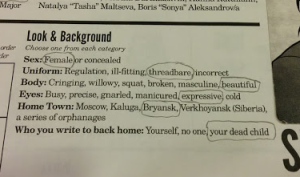Originally published by Mo at Gaming as Women on June 16, 2014
I’ve been having many thoughts recently about stories and gendered (and other marginalized) content, and the practical challenges that groups and individuals face in introducing diversified content to games. While it comes out of a long history of reading and musing and discussions with other Cultural Studies geeks, its recent momentum to get it out of my head and on to Gaming as Women was sparked by (the very smart and articulate) Samara Hayley Steele’s talk Beyond Lords and Ladies at the Living Games Conference in New York City this February, a recent social media discussion that was initiated by GaW’s own Rowan Cota about “the call to adventureâ€, and after I have just completed a playthrough of Ubisoft’s new video game release Child of Light.
When we come to gaming (or any activity) we come to the table with a framing context. We have a pre-established understanding of what a “game†is and what it does, about what a “story†is and what makes for a good one, and about what behaviour appropriately constitutes the “heroic†or “protagonisticâ€. This understanding is developed through our lives via a cumulative and learned process. It is influenced by our locality, our community, our media environment, our critical and educational institutions, and very, very strongly through the process of our socialization (in gender and other attributes).
Our understandings are maintained performatively: when we play or even when we talk about games, stories and characters, we create and talk towards the ideas that confirm our understandings, and casually – often unconsciously – reject those that don’t. When gaming with others we are in a constant process of negotiating, cultivating and policing our communal and personal understandings (even if we never have an actual conversation about or can articulate what we think they should be). Social feedback can come as overt and direct policing: “This plot sucks, dudeâ€. However, the majority of feedback is more subtle and subtextual: ideas get picked up by the group’s attention, excitement, or engagement… or they don’t. As communities form and operate, they are in a constant state of reinforcing communal standards of many things, including what a game, a story or a protagonist is and should be.
Some play communities exist in more isolation than others. For instance, some localized groups have been playing the same game for 25 years with each other who might not be engaging with the culture of gaming as part of their hobby: they don’t talk about it online, go to conventions, or really know anybody outside their home group that plays. However, it’s important to note that even groups like this aren’t operating fully in a vacuum; they will watch movies, read books, and have life experiences that will influence their individual understandings and the way their communal standards evolve over time.
Highly cultivated communities like this will likely have strong network of community standards. Standards will be custom-fit to the needs of the community in question (1), they will feel consistent, be more entrenched and will change with greater difficulty. If newcomers come, they will be more likely to be subject to the community’s standards than to be able to use their own. In short, strong community standards are established enough to form a contextual social gravity. That social gravity is also strong enough in the gaming context to override appeals to the standards of society-at-large.
On the other end of the continuum there are play communities which exist in much more open field. Games may be short or long with a continual ebb and flow of different players that have more, but weaker (and even sometime absent) ties in the gaming context. These players intermix across many different types of games and styles. Greater transitional movement also brings a wider network of ties to the wider culture of gaming through conventions, community events, social networks and social media. Less time in play with specific playgroups provide less consensus-making effort resulting in a more diffuse common core understanding of ideas like game, and story and protagonist. This creates a greater propensity to directly use inherited definitions and recreate power structures from dominant culture and mass media as a shortcut to play.(2)
All this is to say a number of things. Every participant’s experience in the game is subject to some kind of (strong or weak, custom or inherited) definitions of what appropriate play, stories, and characters are, and of what they should do and what they are permitted to be. As I move forward, this is the basis in which I’ll be evaluating how marginalized content, especially gendered content) might meet that model and experience challenge and resistance in integration.
(1)This is not intended to imply that standards in an entrenched community will serve all community members equally; the standards we create recreate and reinforce of the power and status dynamics existing within the community. Socially powerful members of a community will have a greater say in legitimizing standards than others.
(2)This reflection about re-creating the dominant paradigm within open systems is sparked by Samara Hayley Steele’s talk at NYC Living Games. Steele was addressing the propensity for players to recreate dominant power structures within the games fiction when playing in an open world. Once the Living Games publications are available, I highly recommend checking it out. On an unrelated note, you should also check out her talk on LARP and Leisure Labor, it is fascinating!

